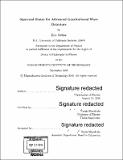| dc.contributor.advisor | Nergis Mavalvala. | en_US |
| dc.contributor.author | Oelker, Eric Glenn | en_US |
| dc.contributor.other | Massachusetts Institute of Technology. Department of Physics. | en_US |
| dc.date.accessioned | 2017-02-22T19:00:53Z | |
| dc.date.available | 2017-02-22T19:00:53Z | |
| dc.date.copyright | 2016 | en_US |
| dc.date.issued | 2016 | en_US |
| dc.identifier.uri | http://hdl.handle.net/1721.1/107044 | |
| dc.description | Thesis: Ph. D., Massachusetts Institute of Technology, Department of Physics, 2016. | en_US |
| dc.description | Cataloged from PDF version of thesis. | en_US |
| dc.description | Includes bibliographical references (pages 219-229). | en_US |
| dc.description.abstract | Quantum vacuum fluctuations impose strict limits on precision displacement measurements, those of interferometric gravitational-wave detectors among them. Introducing squeezed states into an interferometer's readout port can improve the sensitivity of the instrument, leading to richer astrophysical observations. In recent years, this technique has been used to improve the sensitivity of the GEO600 [1011 and the Initial LIGO detector at Hanford, WA [102]. Squeezed states could be employed in advanced gravitational-wave detectors, such as Advanced LIGO, to further push the limits of the observable gravitational wave universe. To maximize the benefit from squeezing, environmentally induced disturbances such as back scattering and angular jitter need to be mitigated. Also, optomechanical interactions dictate that the quadrature of the squeezed vacuum state must rotate by 900 at around 50 Hz in order to achieve a broadband sensitivity improvement for Advanced LIGO. In this thesis we describe a series of experiments that lead to a ultra-high vacuum (UHV) compatible, low phase noise, and frequency-dependent squeezed vacuum source required for Advanced LIGO and future gravitational-wave detectors. In order to develop the required technology, two proof-of-principal experiments were conducted. In the first experiment, we built a UHV compatible squeezed vacuum source and homodyne readout and operated them in UHV conditions. We also commissioned a control scheme that achieved a record low 1.30-7 mrad of phase noise. This is a nearly tenfold improvement over previously reported measurements with audio-band squeezed vacuum sources. In the second experiment we used a 2-m-long, high-finesse optical resonator to produce frequency-dependent squeezed quadrature rotation around 1.2kHz. This demonstration of audio-band frequency-dependent squeezing uses technology and methods that are scalable to the required rotation frequency for Advance LIGO, firmly establishing the viability of this technique for application in current and future gravitational-wave detectors. We conclude with a discussion of the implications of these results for squeezing enhancement in Advanced LIGO and beyond. | en_US |
| dc.description.statementofresponsibility | by Eric Oelker. | en_US |
| dc.format.extent | 229 pages | en_US |
| dc.language.iso | eng | en_US |
| dc.publisher | Massachusetts Institute of Technology | en_US |
| dc.rights | MIT theses are protected by copyright. They may be viewed, downloaded, or printed from this source but further reproduction or distribution in any format is prohibited without written permission. | en_US |
| dc.rights.uri | http://dspace.mit.edu/handle/1721.1/7582 | en_US |
| dc.subject | Physics. | en_US |
| dc.title | Squeezed states for advanced gravitational wave detectors | en_US |
| dc.type | Thesis | en_US |
| dc.description.degree | Ph. D. | en_US |
| dc.contributor.department | Massachusetts Institute of Technology. Department of Physics | |
| dc.identifier.oclc | 970813191 | en_US |
